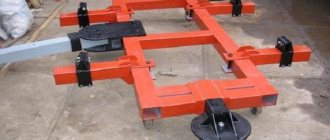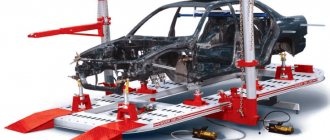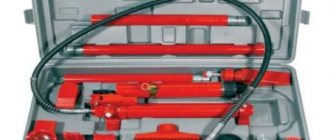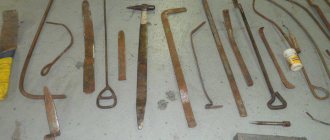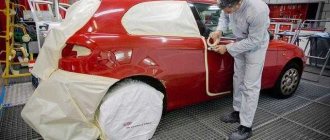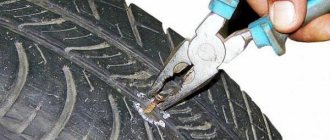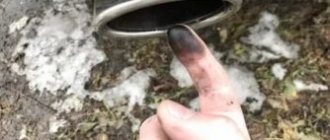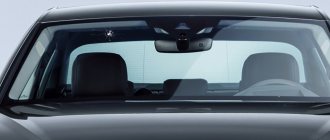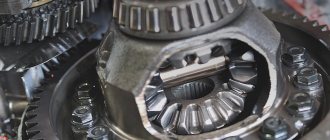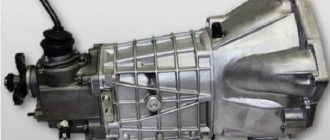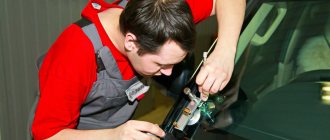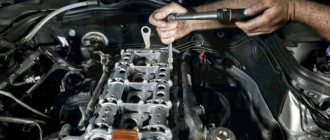Arrangement of the premises
If single repair work can be carried out in the everyday conditions of an ordinary garage, then for regular body repairs it should be turned into a specialized room. First of all, you should equip the garage with an inspection hole or overpass, depending on the characteristics of the room. Lumber can be used to create an overpass.
Also, to ensure the possibility of working in the garage throughout the year, it should be equipped with heating, and insulation will also be required.
The room will need to be heated only for the duration of the body work, and not constantly, so the best option for heating equipment for such a garage is a heat gun.
This device provides the intense heat required for painting.
To connect the heat gun you will need a network. In addition, during body repairs, both pneumatic and electric tools are used, which require a power source, therefore, it is necessary to install a network in the garage. Finally, it is advisable to create spaces in the form of pits for large tools, such as a compressor and welding machine.
Equipment classifications
There are several classifications of tools for body repair. So, according to their purpose, they are divided into the following systems:
- welding;
- compressors;
- grinding;
- straightening;
- finishing tools;
- measuring systems.
According to the stages of body work, which include straightening dents, removing corrosion, painting and preparing for it, tools are divided into appropriate categories. In addition, the classification under consideration includes a group of additional materials.
Based on the operating principle of body repair equipment, it is classified into manual and automatic tools. Models of the second subtype are divided into pneumatic and electric tools based on the power source. The former include, for example, grinding machines, while a paint sprayer is a pneumatic tool.
Straightening hammers
Hammers can vary in size, shape and weight. Impact hammers are most often round or square. There are hammers that have a sharp impact head on the other side of the striker. These types of hammers are used during the final stage of straightening without support. The sharp part allows you to eliminate the elevation and correct the hole. Then the flat part of the striker is applied, the support of which carries out the final alignment.
There are also hammers with impact heads that have teeth that promote shrinkage of the stretched metal. The handles of these hammers are usually made of wood or fiberglass.
During repairs, a hammer is used to straighten out various dents. To work with it, you need to have a certain skill and know when and with what force to tap certain areas.
Hammers are usually made with a slightly convex head, which prevents the edges from touching and resulting damage to the metal.
The blows that are made with a supported straightening hammer are not made with great force (as when driving nails). On the contrary, they are light and gliding. In this case, the hammer must be held freely; the wrist moves during the blow. An experienced master is able to perform about 120 light blows per minute at the same pace. As the hammer bounces, the wrist raises it for another blow. The fingers hold the hammer firmly at the beginning of the blow and at the end. The end of the hammer handle moves in a short arc as the striker moves down and up. At the same time, the hand is calm and relaxed, but continues to control the process so that if something happens, it has time to grab the hammer handle after the rebound.
Using a straightening hammer correctly requires skill. The hammer is always in a state of balance. An unbalanced hammer will result in bounces and will need to be held firmly during impact, which means that an easy blow will no longer be possible. And also you will not be able to maintain one beat rhythm.
Welding
Welding machines are also divided into several types, each of which has certain features of operation and implementation of work. At the same time, they provide different quality of welds. Therefore, you need to choose a welding machine for doing body work yourself based on the requirements for their quality and the skills of the performer.
Thus, AC units are suitable for repairing large faults such as frame welding, but such tools are not used to eliminate minor defects.
When doing body repairs with your own hands, you usually use a tungsten electrode or a carbon dioxide semiautomatic device.
Compressors
These devices also differ in design. There are piston and diaphragm compressor models, and the receiver volume can be from 20 to 50 liters. It is advisable to equip the tool in question for body repair with an oil separating filter. Compressors provide air to pneumatic tools. Also, for painting work, you will need to purchase the pneumatic tool itself, represented by a spray gun.
The considered tools for body repair are the largest, so the above-mentioned pits in the garage are equipped specifically for them.
Straightening
Devices for repairing dents and body defects are varied. Straightening tools are presented:
- hammers;
- spoons;
- anvils;
- notch blocks.
The most optimal options for straightening hammers are considered to be double-sided tools with sides of different shapes. Straightening hammers differ from other hammers in weight and materials. To ensure the ability to straighten dents of various sizes and shapes, you should purchase a set of straightening hammers.
For do-it-yourself body repairs, straightening hammers are used in combination with an anvil or with various blocks designed to soften impacts.
Another tool for car body repair, related to straightening, is represented by a spoon. It is designed for straightening small flat tubercles by distributing the hammer blow over an area. Moreover, you can use a regular hammer with this tool, but sharp folds must be processed with a straightening hammer before using a spoon.
A body repair tool called a figure rod is used to straighten dents in hard-to-reach places. It is a tool from 30 cm to 1 m long with a tip in the form of a chisel or punch. The principle of application is close to the technology of using the above tools.
Anvils intended for body work differ in shape from ordinary ones. There are options in the form of a heel, a chicken egg, and a thumb. Various anvils are used for straightening depending on the shape of the dents, so to carry out body work with your own hands, it is advisable to have several options for these devices.
Knurling blocks are auxiliary tools for body work. They serve to determine where force is applied and support the metal during straightening. To do this, the devices in question are placed on the reverse side of the body fragment being processed. After hitting it, marks remain on the notch block.
Body file
This file is most often used at the initial stage of repair in order to determine the structure of the damage, as well as during the final stage in order to level the metal.
The working part is made of durable steel and has serrations. The holder consists of two handles and a screw tie that regulates the degree of bending of the file.
A decrease or increase in the working area occurs depending on the degree of bending.
Files can also be different in size and shape. They can have different numbers and configurations of teeth. Less rough tools are used when working with aluminum body panels.
The body file is capable of:
- identify the structure of damage during the initial stage of straightening;
- detect small depressions and bends during the final straightening process;
- cut off small hills;
- used in the final leveling process, at the time of applying putty;
- straighten welding seams;
- treat the panel after the tinning process.
The cutting part of the file is always directed outward, in the opposite direction from the straightener who holds it.
When working with a file, the file makes long passes along the entire length of the part. If a file gets stuck, you need to release the pressure on it. All movements are made only from yourself. After completing a pass, the file rises and returns to its original position, then the next pass begins.
Replaceable blades have teeth of different sizes, which are also located with different densities. During the final processing of the part, a high-quality file prepares the surface without leaving scratches or other defects. The result of the work is also influenced by the shape of the teeth (in addition to their size and density).
In order to identify irregularities, in addition to a file, coarse sanding paper is also used with a block or on a sanding machine. The principle of operation remains the same. It is necessary to grind the surface to be straightened. The pits will remain untouched, but the protrusions will be sanded more strongly, and unpolished areas will appear near them. If the existing hills are not very high, then they will be polished, and after this this zone will have the necessary contour.
Sanding and polishing
Equipment designed for cleaning, which includes sandpaper, grinding and polishing machines, are called finishing tools.
As for sandpaper, when doing body work, the most commonly used options for straightening and cleaning working surfaces are P120 - P500 grit.
For stripping sheet metal and processing putty, body files are used, which are distinguished by the presence of a curved holder with variable geometry, which makes it possible to straighten hard-to-reach places.
Power tools, represented by grinding machines, are used for straightening large irregularities, as well as for removing paint and varnish material and primer.
Direct and secondary damage
Direct and indirect (secondary) damage can be divided. Direct damage is the area of the body panel that was in direct contact with the object that caused the damage. This place may have a violation of the integrity of the paintwork or a metal rupture.
Indirect damage has bent and distorted metal located in the area adjacent to the direct damage. Sometimes secondary deformation can be located several tens of centimeters from the area of direct damage. It is difficult to fully define and analyze.
When repairing damage, the repair method is determined by the possibility of accessing the damage from the back of the body panel. If there is access from both sides of the damage, then the straightening method is used with a hammer and support. If there is access only from one side, then other repair techniques are used, such as pulling with a spotter, using an adhesive system or a vacuum suction cup.
When repairing damage, you should try to choose the easiest path. Even if you have special equipment, this does not mean that it needs to be used everywhere and always. If possible, use simple tools, and if necessary, use more complex ones. Sometimes a dent can be squeezed out from the back side by hand, without any tool. It must be remembered that now automakers use fairly thin metal in the production of body panels, so it does not require much effort to restore the deformation.
